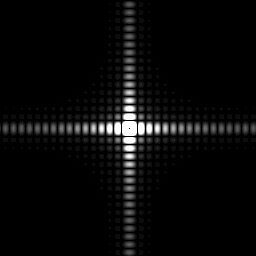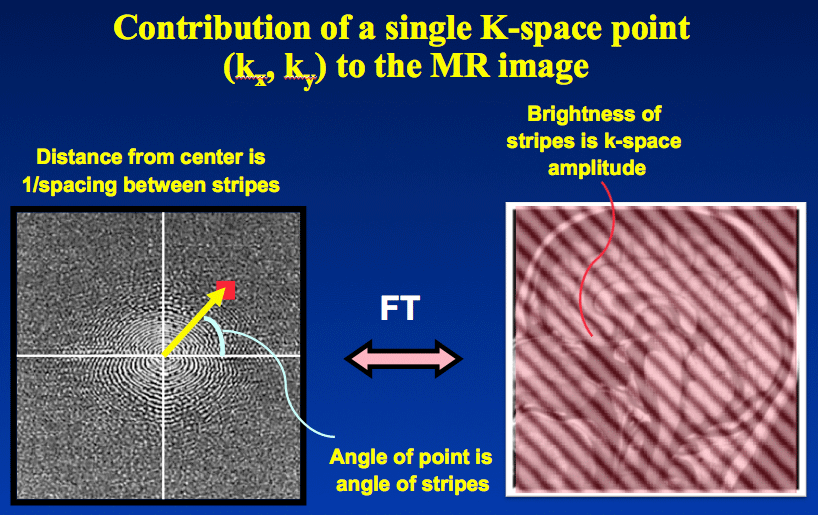The cells of k-space are commonly displayed on rectangular grid with principal axes kx and ky. The kx and ky axes of k-space correspond to the horizontal (x-) and vertical (y-) axes of the image. The k-axes, however, represent spatial frequencies in the x- and y-directions rather than positions. The individual points (kx,ky) in k-space do not correspond one-to-one with individual pixels (x,y) in the image. Each k-space point contains spatial frequency and phase information about every pixel in the final image. Conversely, each pixel in the image maps to every point in k-space.
|
Points along the kx-axis represent frequency components along the x-direction of the image. Conversely, points along the ky-axis reflect frequency components along the y-direction of the image. The k-space image of a square block whose sides are aligned with the x- and y-axes would look like the top image (right).
|
|
If the block were rotated by 45º, the dominant spatial frequencies corresponding to the edges of the block would now be oriented at a 45º angle to the kx- and ky-axes. The relation between angle of the planar image waves and k-space location is shown below.
|
|
As a final note, the physical size of the object imaged and its frequency expanse in k-space are inversely related. In other words, small objects (like the small white circle right) have ripples far out into the periphery of k-space, while larger objects have their spectral energies more concentrated at the center.
As the object grows larger only a few low spatial frequencies in each direction are required to represent it. At the extreme limit (the object fills the entire field-of-view) only a constant Fourier term is needed. For very large objects the k-space representation collapses to just a single data point at (kx, ky) = (0,0) whose value reflects the average brightness of the image.
|
Advanced Discussion (show/hide)»
No supplementary material yet. Check back soon!
References
Mezrich R. A perspective on k-space. Radiology 1995; 195: 297-315. [review].
Miller K. MRI image formation (ppt). On-line lecture notes available at users.fmrib.ox.ac.uk/~karla/teaching/image_formation.ppt
"Spatial frequency". Wikipedia, The Free Encyclopedia.
Mezrich R. A perspective on k-space. Radiology 1995; 195: 297-315. [review].
Miller K. MRI image formation (ppt). On-line lecture notes available at users.fmrib.ox.ac.uk/~karla/teaching/image_formation.ppt
"Spatial frequency". Wikipedia, The Free Encyclopedia.
Related Questions
What is k-space?
If the points in k-space don't correspond to points in the image, what do they mean?
What are 2D- and 3D-Fourier transforms? I don't see how FT works in higher dimensions.
What is k-space?
If the points in k-space don't correspond to points in the image, what do they mean?
What are 2D- and 3D-Fourier transforms? I don't see how FT works in higher dimensions.









